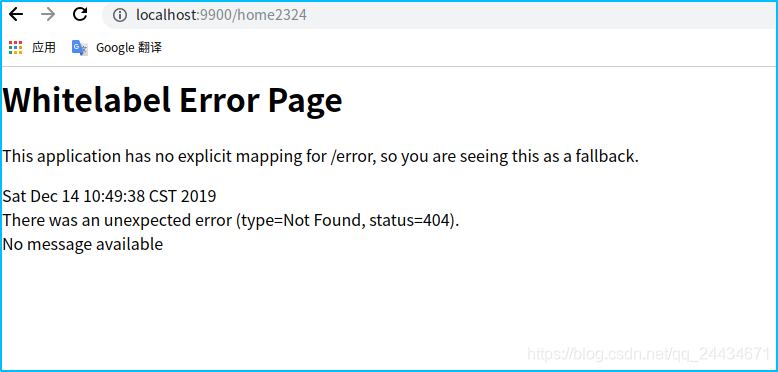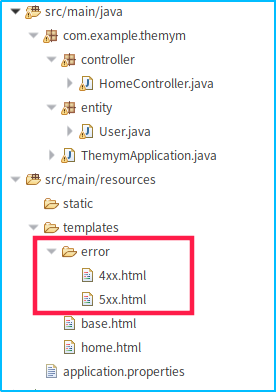今天给大家分享一篇SpringBoot2.x中如何自定义状态为400和500的错误页面。接下来我们来看默认的页面。

以上是一个404的错误。再来看一个500的错误。

在SpringBoot2.x中我们可以找到BasicErrorController,这个类主要用来处理异常
/*
* Copyright 2012-2019 the original author or authors.
*
* Licensed under the Apache License, Version 2.0 (the "License");
* you may not use this file except in compliance with the License.
* You may obtain a copy of the License at
*
* https://www.apache.org/licenses/LICENSE-2.0
*
* Unless required by applicable law or agreed to in writing, software
* distributed under the License is distributed on an "AS IS" BASIS,
* WITHOUT WARRANTIES OR CONDITIONS OF ANY KIND, either express or implied.
* See the License for the specific language governing permissions and
* limitations under the License.
*/
package org.springframework.boot.autoconfigure.web.servlet.error;
import java.util.Collections;
import java.util.List;
import java.util.Map;
import javax.servlet.http.HttpServletRequest;
import javax.servlet.http.HttpServletResponse;
import org.springframework.boot.autoconfigure.web.ErrorProperties;
import org.springframework.boot.autoconfigure.web.ErrorProperties.IncludeStacktrace;
import org.springframework.boot.web.servlet.error.ErrorAttributes;
import org.springframework.boot.web.servlet.server.AbstractServletWebServerFactory;
import org.springframework.http.HttpStatus;
import org.springframework.http.MediaType;
import org.springframework.http.ResponseEntity;
import org.springframework.stereotype.Controller;
import org.springframework.util.Assert;
import org.springframework.web.bind.annotation.RequestMapping;
import org.springframework.web.servlet.ModelAndView;
/**
* Basic global error {@link Controller @Controller}, rendering {@link ErrorAttributes}.
* More specific errors can be handled either using Spring MVC abstractions (e.g.
* {@code @ExceptionHandler}) or by adding servlet
* {@link AbstractServletWebServerFactory#setErrorPages server error pages}.
*
* @author Dave Syer
* @author Phillip Webb
* @author Michael Stummvoll
* @author Stephane Nicoll
* @since 1.0.0
* @see ErrorAttributes
* @see ErrorProperties
*/
@Controller
//如果没有配置server.error.path就去error.path找,如果没有配置默认路径为/error
@RequestMapping("${server.error.path:${error.path:/error}}")
public class BasicErrorController extends AbstractErrorController {
private final ErrorProperties errorProperties;
/**
* Create a new {@link BasicErrorController} instance.
* @param errorAttributes the error attributes
* @param errorProperties configuration properties
*/
public BasicErrorController(ErrorAttributes errorAttributes, ErrorProperties errorProperties) {
this(errorAttributes, errorProperties, Collections.emptyList());
}
/**
* Create a new {@link BasicErrorController} instance.
* @param errorAttributes the error attributes
* @param errorProperties configuration properties
* @param errorViewResolvers error view resolvers
*/
public BasicErrorController(ErrorAttributes errorAttributes, ErrorProperties errorProperties,
List<ErrorViewResolver> errorViewResolvers) {
super(errorAttributes, errorViewResolvers);
Assert.notNull(errorProperties, "ErrorProperties must not be null");
this.errorProperties = errorProperties;
}
@Override
public String getErrorPath() {
return this.errorProperties.getPath();
}
//如果是浏览器请求的话进入这个
@RequestMapping(produces = MediaType.TEXT_HTML_VALUE)
public ModelAndView errorHtml(HttpServletRequest request, HttpServletResponse response) {
HttpStatus status = getStatus(request);
Map<String, Object> model = Collections
.unmodifiableMap(getErrorAttributes(request, isIncludeStackTrace(request, MediaType.TEXT_HTML)));
response.setStatus(status.value());
ModelAndView modelAndView = resolveErrorView(request, response, status, model);
//这里是去error下面找
return (modelAndView != null) ? modelAndView : new ModelAndView("error", model);
}
//非浏览器请求的话进入这个,主要是利用MediaType.TEXT_HTML_VALUE来区分
@RequestMapping
public ResponseEntity<Map<String, Object>> error(HttpServletRequest request) {
HttpStatus status = getStatus(request);
if (status == HttpStatus.NO_CONTENT) {
return new ResponseEntity<>(status);
}
Map<String, Object> body = getErrorAttributes(request, isIncludeStackTrace(request, MediaType.ALL));
return new ResponseEntity<>(body, status);
}
/**
* Determine if the stacktrace attribute should be included.
* @param request the source request
* @param produces the media type produced (or {@code MediaType.ALL})
* @return if the stacktrace attribute should be included
*/
protected boolean isIncludeStackTrace(HttpServletRequest request, MediaType produces) {
IncludeStacktrace include = getErrorProperties().getIncludeStacktrace();
if (include == IncludeStacktrace.ALWAYS) {
return true;
}
if (include == IncludeStacktrace.ON_TRACE_PARAM) {
return getTraceParameter(request);
}
return false;
}
/**
* Provide access to the error properties.
* @return the error properties
*/
protected ErrorProperties getErrorProperties() {
return this.errorProperties;
}
}
SpringBoot2.x发生404或者500后默认会去claspath下面的templates/error目录下查找,4xx或者是5xx,这里的xx代表了404,401等异常错误。

增加了error/4xx.html 和 5xx.html再次访问页面我们来看效果:

接下来访问一个404的错误来看看:

接下来我们来看SpringBoot默认返回的错误信息,通过DefaultErrorAttruites类可以找到:
/*
* Copyright 2012-2019 the original author or authors.
*
* Licensed under the Apache License, Version 2.0 (the "License");
* you may not use this file except in compliance with the License.
* You may obtain a copy of the License at
*
* https://www.apache.org/licenses/LICENSE-2.0
*
* Unless required by applicable law or agreed to in writing, software
* distributed under the License is distributed on an "AS IS" BASIS,
* WITHOUT WARRANTIES OR CONDITIONS OF ANY KIND, either express or implied.
* See the License for the specific language governing permissions and
* limitations under the License.
*/
package org.springframework.boot.web.servlet.error;
import java.io.PrintWriter;
import java.io.StringWriter;
import java.util.Date;
import java.util.LinkedHashMap;
import java.util.Map;
import javax.servlet.ServletException;
import javax.servlet.http.HttpServletRequest;
import javax.servlet.http.HttpServletResponse;
import org.springframework.core.Ordered;
import org.springframework.core.annotation.Order;
import org.springframework.http.HttpStatus;
import org.springframework.util.StringUtils;
import org.springframework.validation.BindingResult;
import org.springframework.validation.ObjectError;
import org.springframework.web.bind.MethodArgumentNotValidException;
import org.springframework.web.context.request.RequestAttributes;
import org.springframework.web.context.request.WebRequest;
import org.springframework.web.servlet.HandlerExceptionResolver;
import org.springframework.web.servlet.ModelAndView;
/**
* Default implementation of {@link ErrorAttributes}. Provides the following attributes
* when possible:
* <ul>
* <li>timestamp - The time that the errors were extracted</li>
* <li>status - The status code</li>
* <li>error - The error reason</li>
* <li>exception - The class name of the root exception (if configured)</li>
* <li>message - The exception message</li>
* <li>errors - Any {@link ObjectError}s from a {@link BindingResult} exception
* <li>trace - The exception stack trace</li>
* <li>path - The URL path when the exception was raised</li>
* </ul>
*
* @author Phillip Webb
* @author Dave Syer
* @author Stephane Nicoll
* @author Vedran Pavic
* @since 2.0.0
* @see ErrorAttributes
*/
@Order(Ordered.HIGHEST_PRECEDENCE)
public class DefaultErrorAttributes implements ErrorAttributes, HandlerExceptionResolver, Ordered {
private static final String ERROR_ATTRIBUTE = DefaultErrorAttributes.class.getName() + ".ERROR";
private final boolean includeException;
/**
* Create a new {@link DefaultErrorAttributes} instance that does not include the
* "exception" attribute.
*/
public DefaultErrorAttributes() {
this(false);
}
/**
* Create a new {@link DefaultErrorAttributes} instance.
* @param includeException whether to include the "exception" attribute
*/
public DefaultErrorAttributes(boolean includeException) {
this.includeException = includeException;
}
@Override
public int getOrder() {
return Ordered.HIGHEST_PRECEDENCE;
}
@Override
public ModelAndView resolveException(HttpServletRequest request, HttpServletResponse response, Object handler,
Exception ex) {
storeErrorAttributes(request, ex);
return null;
}
private void storeErrorAttributes(HttpServletRequest request, Exception ex) {
request.setAttribute(ERROR_ATTRIBUTE, ex);
}
@Override
public Map<String, Object> getErrorAttributes(WebRequest webRequest, boolean includeStackTrace) {
Map<String, Object> errorAttributes = new LinkedHashMap<>();
//这里添加返回的错误信息
errorAttributes.put("timestamp", new Date());
addStatus(errorAttributes, webRequest);
addErrorDetails(errorAttributes, webRequest, includeStackTrace);
addPath(errorAttributes, webRequest);
return errorAttributes;
}
private void addStatus(Map<String, Object> errorAttributes, RequestAttributes requestAttributes) {
Integer status = getAttribute(requestAttributes, "javax.servlet.error.status_code");
if (status == null) {
errorAttributes.put("status", 999);
errorAttributes.put("error", "None");
return;
}
errorAttributes.put("status", status);
try {
errorAttributes.put("error", HttpStatus.valueOf(status).getReasonPhrase());
}
catch (Exception ex) {
// Unable to obtain a reason
errorAttributes.put("error", "Http Status " + status);
}
}
private void addErrorDetails(Map<String, Object> errorAttributes, WebRequest webRequest,
boolean includeStackTrace) {
Throwable error = getError(webRequest);
if (error != null) {
while (error instanceof ServletException && error.getCause() != null) {
error = error.getCause();
}
if (this.includeException) {
errorAttributes.put("exception", error.getClass().getName());
}
addErrorMessage(errorAttributes, error);
if (includeStackTrace) {
addStackTrace(errorAttributes, error);
}
}
Object message = getAttribute(webRequest, "javax.servlet.error.message");
if ((!StringUtils.isEmpty(message) || errorAttributes.get("message") == null)
&& !(error instanceof BindingResult)) {
errorAttributes.put("message", StringUtils.isEmpty(message) ? "No message available" : message);
}
}
private void addErrorMessage(Map<String, Object> errorAttributes, Throwable error) {
BindingResult result = extractBindingResult(error);
if (result == null) {
errorAttributes.put("message", error.getMessage());
return;
}
if (result.hasErrors()) {
errorAttributes.put("errors", result.getAllErrors());
errorAttributes.put("message", "Validation failed for object='" + result.getObjectName()
+ "'. Error count: " + result.getErrorCount());
}
else {
errorAttributes.put("message", "No errors");
}
}
private BindingResult extractBindingResult(Throwable error) {
if (error instanceof BindingResult) {
return (BindingResult) error;
}
if (error instanceof MethodArgumentNotValidException) {
return ((MethodArgumentNotValidException) error).getBindingResult();
}
return null;
}
private void addStackTrace(Map<String, Object> errorAttributes, Throwable error) {
StringWriter stackTrace = new StringWriter();
error.printStackTrace(new PrintWriter(stackTrace));
stackTrace.flush();
errorAttributes.put("trace", stackTrace.toString());
}
private void addPath(Map<String, Object> errorAttributes, RequestAttributes requestAttributes) {
String path = getAttribute(requestAttributes, "javax.servlet.error.request_uri");
if (path != null) {
errorAttributes.put("path", path);
}
}
@Override
public Throwable getError(WebRequest webRequest) {
Throwable exception = getAttribute(webRequest, ERROR_ATTRIBUTE);
if (exception == null) {
exception = getAttribute(webRequest, "javax.servlet.error.exception");
}
return exception;
}
@SuppressWarnings("unchecked")
private <T> T getAttribute(RequestAttributes requestAttributes, String name) {
return (T) requestAttributes.getAttribute(name, RequestAttributes.SCOPE_REQUEST);
}
}
如果要想自定义扩展返回的信息怎么办呢,可以自定义一个类来继承这个类,代码如下:
@Component
class CustomDefaultErrorAttribute extends DefaultErrorAttributes{
@Override
public Map<String, Object> getErrorAttributes(WebRequest webRequest, boolean includeStackTrace) {
// TODO Auto-generated method stub
Map<String, Object> map = new HashMap<String, Object>();
map.put("compay", "深证腾讯计算公司");
//调用父类来添加之前Spring的错误信息
map.putAll(super.getErrorAttributes(webRequest, includeStackTrace));
return map;
}
}页面获取的代码如下:

有问题可以在评论区留言,技术问题可以私信我。
